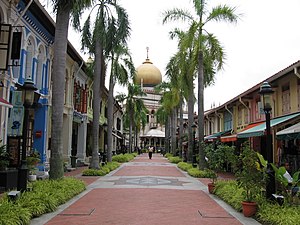Template:SG neighbourhood


Kampong Glam is a neighbourhood in Singapore, a city-state in Southeast Asia. It is located north of the Singapore River, in the urban planning area of Rochor.
Template:SG neighbourhood


Kampong Glam is a neighbourhood in Singapore, a city-state in Southeast Asia. It is located north of the Singapore River, in the urban planning area of Rochor.
Prior to colonization by the British in 1819, the area was home to the Malay aristocracy of Singapore. It became prominent and more populous after the signing of a treaty between the British East India Company, Sultan Hussein Shah of Johor and Temenggong Abdul Rahman in 1819. The company was given the right to set up a trading post in Singapore under this treaty.
During the colony's early history, under the Raffles Plan of 1822, the settlement was divided according to different ethnic groups which included European Town, Chinese, Chulia, Arab and Bugis kampongs. Kampong Glam was designated for the Sultan of Singapore and his household, as well as the Malay and Arab communities, many of whom were merchants. It was situated east of what was then the European Town.
While the Temenggong and his followers settled in Telok Blangah, Sultan Hussein, his family and followers settled in Kampong Glam. In return, the Sultan was given large areas of land for residential use in Kampong Glam under the treaty. The land was allocated to the Malays and other Muslim immigrants to Singapore, including the Malays from Melacca, the Riau Islands and Sumatra in Indonesia.
The second half of the nineteenth century saw the rapid growth of immigrant communities in Kampong Glam, initially from Sumatra, and later from other parts of Indonesia and Malaya. This resulted in the setting up of different kampongs, like Kampong Malacca, Kampong Java and Kampong Bugis. There were also a small but successful Arab community of traders in the area.
In the early twentieth century, commercial activities in Kampong Glam expanded as new shophouses and residential buildings were built. A multi-ethnic community soon developed there, comprising not only Malays and Arabs but also the Chinese and Indians.
Later, due to an expansion of commercial activities and an increase in immigrant settlers in Kampong Glam, the Arabs moved to areas like Joo Chiat, Tanglin and Bukit Tunggal (the stretch of Dunearn Road near the junction of Balmoral Road and Chancery Lane, near Anglo-Chinese School (Barker Road) today, was called Tunggal Road).
This ethnic area still retains strong ties to the ethnic-Malay and Muslim community, and has sometimes been termed the "Muslim Quarter" due to its history. When more crowded conditions later arose as the colony grew, some of these ethnic populations moved into the Geylang neighbourhood.
Since the 1980s, several large portions of the area have been declared National Heritage sites and have been protected for conservation. Some of these conserved areas in Kampong Glam include the Sultan Mosque, the Hajjah Fatimah Mosque and the Istana Kampong Glam, the palace of the former Sultan of Singapore.
The area's name derives from two Malay words, Kampung, meaning "village" or "settlement," and Glam (or Gelam) referring to a variety of eucalyptus (Malaleuca leucadendron) which grew in the area. Its bark was used by boat builders in the village to caulk or seal boats. Its leaves also provided cajeput oil which could be used to treat muscular ache and pain as well as respiratory problems. Gelam trees can live up to 100 years and grow up to 30 metres.
The Bugis MRT Station is generally considered to be the primary Mass Rapid Transit (MRT) Station that serves Kampong Glam, although this is not strictly so. It also has a number of bus services integrating it into Singapore's transport system.
Kampong Glam is a division of Jalan Besar Group Representation Constituency, which includes parts of the Downtown Core. Former Deputy Prime Minister Sinnathamby Rajaratnam was its Member of Parliament (MP) until 1988 when Loh Meng See took over and served until 2006. The current MP is Denise Phua.